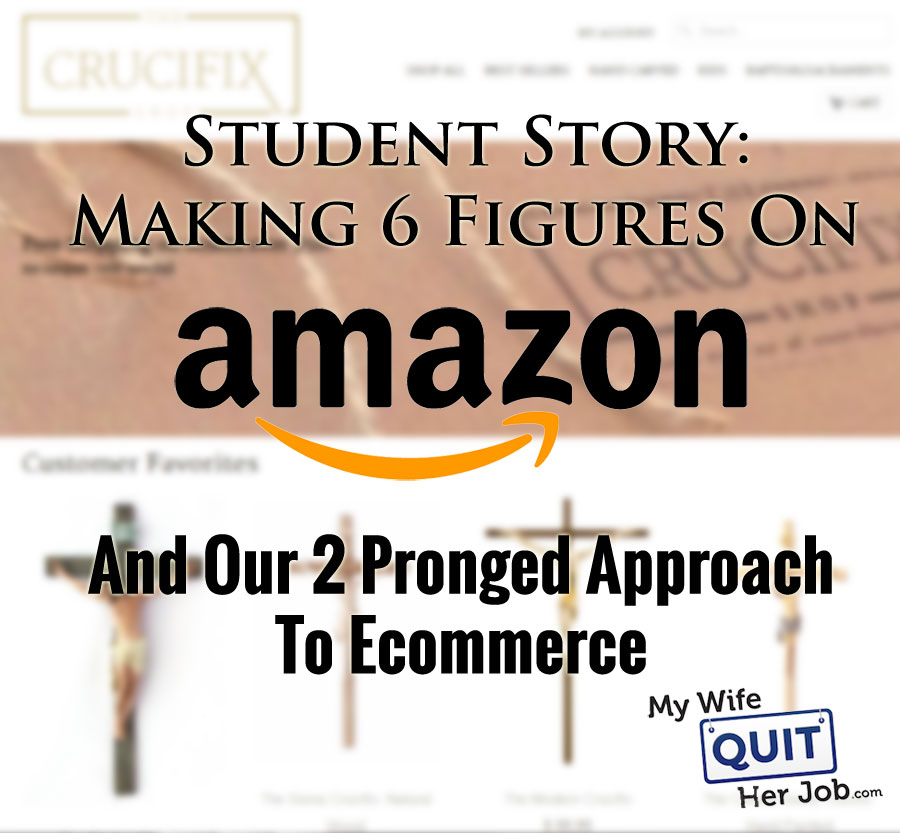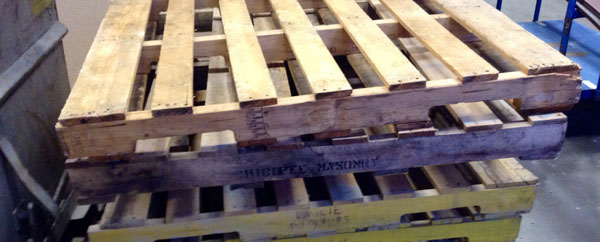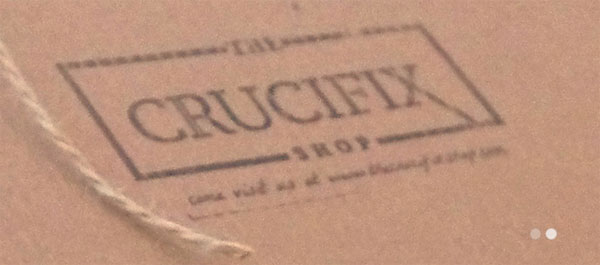This post was written by Lauren, a student in my Create A Profitable Online Store Course.
One of the basic tenets of my course is to validate your niche or product idea on an established marketplace like Amazon before investing in a full blown shop.
And as part of the class, I offer detailed tutorials on how to make your Amazon listings stand out and sell like crazy.
Anyway when Lauren launched her first product on Amazon, it took off so fast that she’s on track to make 6 figures from just a single product alone! Needless to say, her niche is pretty darn lucrative:)
In this post, Lauren discusses her experiences and her 2 prong approach to ecommerce.
Hi there, my name is Lauren and I am the proud founder of both an Amazon store and my own branded shop. A few months ago my husband and I decided to finally get serious about being entrepreneurs “someday” when we had a huge round of corporate layoffs at our company.
This was the jumpstart we needed to start reading books again at the library on business and looking online for good e-commerce articles. One of those articles was from a guy named Steve Chou who had a site called MyWifeQuitHerJob.com- just what we were trying to do!
We listened to the 6 part mini series of free classes and were hooked, so we went through the full blown course.
I have had lots of formal schooling, but what I love about Steve’s class is that it isn’t classroom theory. You learn practical skills that can be executed immediately.
I think some would say that I became obsessed with e-commerce but I prefer “passionate” or “driven” to describe the 3-4 hours a night that I devoted to learning everything I could about online shops.
After putting in 9 hours at the day job and our evening marathon to feed, play with and put to bed our 3 small kids, I would hop online and get to work at my “other” job: e-commerce.
They say that diversification is key in business ventures and stock purchases, so why not apply this to e-commerce as well? We took a 2 prong approach and decided to build a stand-alone site as well as try selling products on an established e-commerce platform like Amazon.
Get My Free Mini Course On How To Start A Successful Ecommerce Store
If you are interested in starting an ecommerce business, I put together a comprehensive package of resources that will help you launch your own online store from complete scratch. Be sure to grab it before you leave!
Beginning With Amazon
Let’s start with Amazon. We noticed a gap in the baby category on Amazon (as a mother with 3 small kids my mind is constantly churning on new baby product ideas).
I have a background in product development and innovation, and my specific sweet spot is not inventing products from scratch but making “me too +” products- basically enhancing products that are already on the market.
We bought a few wholesale products and white labeled them using the logo we created through fiverr.com designers (total cost $10) and bought a few barcodes (also super cheap).
Total we spent less than $100 for our beta test in the Amazon e-commerce world.
In December of last year we sold our first product. Honestly, I was completely floored. Our test product had worked! Then every few days we got a sale until 3 weeks later we were sold out of the test products.
Once these first 25 sold we bought another 500 and decided to use Amazon’s FBA fulfillment centers so we wouldn’t have to manually ship each one every time an order came in.
A funny thing happened.
We started selling 100 a week.
Then I played around with the pricing and raised it by a dollar. We sold even more. They started selling so fast over the next 2 months that we were cleaning out the inventory of our vendors and using every waking moment to package our product at the kitchen table.
Automating The Process
Can I tell you that hand packing 3,000 small products is a great motivator to find an automated solution?
We started making calls to retail packaging companies, and found one that met our needs and price point. We took the plunge and bought 10,000 of our product wholesale. We had them shipped to our retail packager.
A few weeks later, 4 pallets of finished goods arrived at our house (and got lots of raised eyebrows from the neighbors when the 18 wheeler arrived at our front steps), which we immediately shipped to Amazon FBA facilities.
Within 6 weeks they have paid for themselves and we are now in the sweet spot of profit flowing in but not having to replenish product just yet.
This year we are tracking to drive six figures in revenue from this one product.
It is an unbelievable feeling to realize that you can create something out of nothing, especially when that something can provide financial freedom to your family.
Reducing Our Dependence On Amazon
Now let’s talk about our e-commerce site. We wanted to learn how to build a site from scratch and how search engine optimization worked.
While we were testing our products on Amazon, we were also researching niche product areas that we could build an entire store around and not just sell individual, one off products..
Both of us are religious, so we honed in on crosses and crucifixes after extensive research using Market Samurai, SEO quake and the Google Keyword Planner. The word “Crucifix” is one of the keywords we are targeting, as there are not a ton of competitors for this search word.
We did a ton of online research on crucifixes and where to buy them (we found these using Google, but recently started using ReferenceUSA for free through our library). Next we purchased a lean inventory of crucifixes from Italy and American wholesalers.
I will note that it took several weeks to set up accounts with our Italian vendors because of the language barrier and difference in time zone and sense of urgency.
Creating The Website
Next was website creation. We first started down the Blue Host/Open source shopping cart route. I spent 3 weeks pulling my hair out trying to learn “simple” coding. My husband gently reminded me that while product innovation and sales are my core competencies, web development is most certainly not.
Feeling both defeated and relieved, I decided to sign up for Shopify’s fully hosted services and had a much easier time getting our site up and running.
Editor’s Note: Some people are just not cut out for open source. If you don’t want to deal with any technical issues whatsoever with your website, then I highly recommend a fully hosted solution like Shopify or Big Commerce
I must admit that a large chunk of time went into understanding how to maneuver the shopify site. It is fairly intuitive, but it takes some practice building your site the way you want it. I cannot even tell you how many hours I spent tweaking the site.
Steve mentions in his course that if you just copy and paste the manufacturer’s pictures, it’s harder to differentiate yourself from the competition. We decided to take all our own product photos using a $20 light box from amazon. We launched the site soon after and had our first sale within the week!
Now the focus is on search engine optimization and tweaking content to drive more sales. While we have a pipeline of additional products, we are focusing right now on driving traffic to our site and decreasing the bounce rate on our home screen.
Lesson’s Learned
Steve Chou’s Create A Profitable Online Store Course has been a great source of inspiration and tactical ways to improve our store. Once we have a firm grasp on search engine optimization and sales funnel optimization (aka selling stuff), we’ll start looking to expand products.
We are also learning that while the competition isn’t too tight for our initial keyword “crucifix,” there are many variations of this keyword and all are pretty competitive. Our goal is to showcase our unique point of view so that customers want to buy from us rather than the competition.
So what have I learned from all of this?
- Don’t be afraid to test a product on a small scale.
- Amazon can be both a testing ground as well as a profit center for you.
- If you make a mistake, dust yourself off and get back in the game.
- In this business there is no such thing as an expert in everything, so focus on your core competencies and find ways to be adequate in areas you struggle (or hire it out!)
Wishing you the best, Lauren
If you are interested in joining my Create A Profitable Online Store Course, then click here sign up now!
photo credit: Pallets

Ready To Get Serious About Starting An Online Business?
If you are really considering starting your own online business, then you have to check out my free mini course on How To Create A Niche Online Store In 5 Easy Steps.
In this 6 day mini course, I reveal the steps that my wife and I took to earn 100 thousand dollars in the span of just a year. Best of all, it's free and you'll receive weekly ecommerce tips and strategies!
Related Posts In Student Shops
- Student Shop – How Tracey Created A Profitable Online Store Selling Fair Trade Jewelry
- Student Shop: Selling Handmade Pottery Online At CherricoPottery.com
- Student Story: How Lauren Makes 6 Figures Selling On Amazon And Her 2 Prong Approach To Ecommerce
- How My Student Tracey Sells Products In The United States From A Foreign Country
- Student Story: How Carmen Went From Zero To 6 Figures Selling Resort Wear In Australia

Steve Chou is a highly recognized influencer in the ecommerce space and has taught thousands of students how to effectively sell physical products online over at ProfitableOnlineStore.com.
His blog, MyWifeQuitHerJob.com, has been featured in Forbes, Inc, The New York Times, Entrepreneur and MSNBC.
He's also a contributing author for BigCommerce, Klaviyo, ManyChat, Printful, Privy, CXL, Ecommerce Fuel, GlockApps, Privy, Social Media Examiner, Web Designer Depot, Sumo and other leading business publications.
In addition, he runs a popular ecommerce podcast, My Wife Quit Her Job, which is a top 25 marketing show on all of Apple Podcasts.
To stay up to date with all of the latest ecommerce trends, Steve runs a 7 figure ecommerce store, BumblebeeLinens.com, with his wife and puts on an annual ecommerce conference called The Sellers Summit.
Steve carries both a bachelors and a masters degree in electrical engineering from Stanford University. Despite majoring in electrical engineering, he spent a good portion of his graduate education studying entrepreneurship and the mechanics of running small businesses.
















Hey great job! That’s awesome that you had so much, fast, success with Amazon. I am guessing you’re own shop will take more time to generate traffic than the amazon listing, am I right? Are you doing all the SEO on your own or do you plan on outsourcing it? Have you tried Google Adwords?
Hi John, we work with a SEO company to help get us going on our .com, to learn the ropes and have professionals help with this because of time constraints, raising a family etc etc. We do use Google Adwords, and are still learning and trying ways to optimize our ads.
Hi Lauren,
Im kind of confused because you first hint at a baby product you sold on Amazon then you switched over to talking about your crucifix shop. Why didn’t you continue selling the first product, or are you still doing that on Amazon while building this second online store?
Or did you decide that the first product simply wasn’t sustainable or profitable enough? I think it would have been helpful to have that answer in the article, but if you can provide the answer in the comments even better.
Thanks,
Jeremy
She is probably keeping the product she is selling on Amazon a secret and she is smart to do so. Too many people see products that are selling well on Amazon and find the vendor and sell it themselves. Her personal website will be harder to infringe on so she can be more transparent. Way to go Lauren! Keep it up!!
Hi Jeremy, we have tested several niches and keep the ones that stick. Both baby products and crucifixes are good for us right now, others that have not been great we do not continue to sell. Hope this helps!
Woo, that is an AMAZING product launch, many congratulations. The two pronged approach sounds like it is boatloads of work, but at least you’ve got some risk diversification. That said, it sounds like you knocked one out of the park already!
I Enjoyed reading this article keep up the great work, thank you
Awesome ideas here! It’s amazing seeing what things like amazon can do for us financially. Sounds like you’ve got it down to a science!
Interesting article. Thanks for the great tips on eCommerce and entrepreneurial strategies!
A little confused, if the retail packaging company was packaging your product why couldnt they ship directly to Amazon instead of delivering pallets to your house?
Baby steps… That’s most likely the next optimization.
Steve is right, that is the next level of optimization 🙂
Huh?? I don’t get that at all as the answer to the question of why the packaging company didn’t ship to Amazon. Seems that would have saved you a boatload of money. Since we all are just learning, can you expound on that please?
What are the barcodes for?
We white label/ private label some products, and when you create a product it needs its own unique barcode. You can purchase these online from reputable sources.
Hi Lauren,
It is very motivating to read your article. Right now I’m also working on a baby product which is my niche. My question is ” is private labelling and barcode a must for all products? Can I sell without barcode?”
Not 100% certain. But I think Amazon FBA requires barcodes.
Thank You for sharing your experiences. Great article.
Lauren, could you describe your product development + innovation process? Thanks!
It would help if this blog article and the blog comments had dates. It is critical to know when things were created and done online because things are EVER changing. No one has any idea when all this happened.
Inspiring and motivating story… sad to find that Lauren’s website is not currently available for viewing (June 2016).
Hey Heidi,
I’m reaching out to her to see what her plans are and whether she’s decided to sell her Amazon products on her own website now instead of crucifixes.
Hey Heidi, we do small pilot runs with products and .com stores and keep the ones that are profitable. TheCrucifixShop.com was one of those product lines that WE were super passionate about, but the market was not. This was the same for a company we had for a short time called spunkaroo.com that sold toys. We pilot a lot of our products on the Amazon platform and then build brands around those that are a success. We have 2 other active .coms that we use today that we are focused on building out and moving into distributing.
Hope this helps!
Hi Lauren, great story, thanks for sharing.
I am just wondering, how can we using Amazon fulfillment but not letting them know what is it?